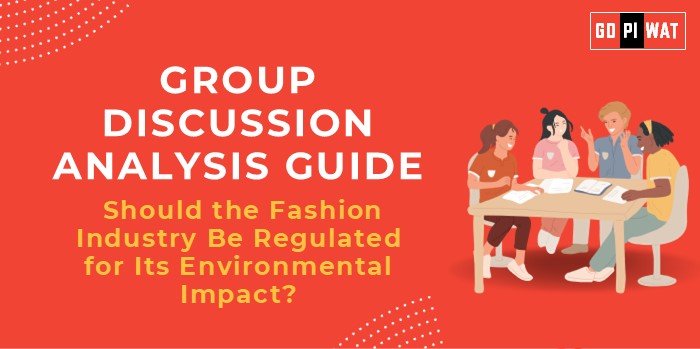📋 Group Discussion (GD) Analysis Guide
🌍 Should the Fashion Industry Be Regulated for Its Environmental Impact?
🌟 Introduction to the Topic
The fashion industry is a global powerhouse, valued at over $2.5 trillion, but its environmental cost is immense. From water pollution to textile waste, its operations significantly impact ecosystems. As sustainability gains prominence in global discourse, regulating fashion’s environmental impact has emerged as a critical question, especially for B-school discussions where environmental, economic, and ethical dimensions intersect.
📊 Quick Facts and Key Statistics
- 🌍 Global Emissions: The fashion industry contributes to 10% of global carbon emissions annually, more than aviation and shipping combined.
- 💧 Water Usage: Producing one cotton shirt requires 2,700 liters of water—enough for one person’s drinking needs for 2.5 years.
- ♻️ Textile Waste: 92 million tons of textile waste are generated yearly, with only 15% recycled.
- 📈 Consumer Trends: Fast fashion sales have increased by 60% since 2000, exacerbating resource depletion.
- 🌱 Environmental Costs: Polyester production releases 706 million tons of greenhouse gases yearly, with decomposition taking 200+ years.
🤝 Stakeholders and Their Roles
- Governments: Legislate sustainability standards and monitor compliance.
- Corporates: Implement eco-friendly practices and ensure transparency in supply chains.
- Consumers: Drive demand for sustainable fashion and support ethical brands.
- NGOs: Advocate for environmental justice and support green initiatives.
- International Organizations: Frame global sustainability guidelines like those in the UN’s SDG 12 (Responsible Consumption and Production).
🏆 Achievements and Challenges
✅ Achievements
- Eco-Friendly Innovations: Sustainable brands like Patagonia and Stella McCartney lead with innovations in recycled materials.
- Global Initiatives: The Ellen MacArthur Foundation’s circular fashion program promotes reuse and recycling.
- Consumer Awareness: Rising demand for ethical products, with 67% of millennials preferring eco-conscious brands.
⚠️ Challenges
- Regulatory Gaps: Inconsistent global standards hinder enforcement of sustainable practices.
- Cost Concerns: Sustainable materials often have higher production costs, affecting affordability.
- Fast Fashion Dominance: Companies prioritize volume and low prices over sustainability.
- Waste Management: Lack of scalable recycling solutions for textiles.
🌍 Global Comparisons
- 💡 Success: European Union’s Circular Economy Action Plan mandates eco-design for textiles.
- 📉 Challenges: Developing countries struggle with informal waste management systems.
📚 Case Studies
- Bangladesh: The garment industry’s water footprint raises questions about balancing economic benefits with environmental costs.
- Netherlands: Amsterdam’s initiative to reduce textile waste by 50% by 2030.
📖 Structured Arguments for Discussion
- Supporting Stance: “Regulating the fashion industry is essential to mitigate its immense carbon footprint and water pollution levels.”
- Opposing Stance: “Excessive regulation could harm employment in developing nations dependent on fast fashion manufacturing.”
- Balanced Perspective: “While regulation is vital, fostering innovation and incentivizing sustainability can ensure equitable progress.”
🎯 Effective Discussion Approaches
- Opening Approaches:
- 📊 Statistical Hook: “Did you know the fashion industry is the second-largest consumer of water globally?”
- 🌍 Contrast Angle: “While the industry empowers millions economically, it risks depleting global resources at an alarming rate.”
- 📚 Case Study Start: “Bangladesh’s textile boom has come at the cost of water bodies turning toxic.”
- Counter-Argument Handling: Highlight economic trade-offs and suggest practical solutions like subsidies for green technologies.
📈 Strategic Analysis of Strengths and Weaknesses
- Strengths: Drives GDP and employment globally; increasing adoption of circular economy models.
- Weaknesses: High carbon footprint and waste generation; lack of consumer awareness in emerging markets.
- Opportunities: Innovations in biodegradable fabrics; partnerships for green certifications.
- Threats: Rising costs of sustainable production; pushback from unregulated players.
📚 Connecting with B-School Applications
- Real-World Applications: Integration of ESG frameworks in fashion supply chains; CSR initiatives for green brands.
- Sample Interview Questions:
- “What role should businesses play in balancing profitability and sustainability?”
- “How can regulations foster innovation in fashion?”
- Insights for Students:
- Focus on scalable sustainability solutions.
- Explore the intersection of business ethics and environmental law.


